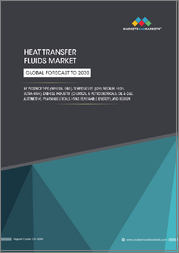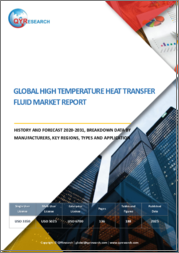
|
시장보고서
상품코드
1450339
열전달 유체(HTF)의 성장 기회Growth Opportunities in Heat Transfer Fluids |
||||||
전략적 인수와 파트너십이 사업 확대의 열쇠
HTF(열전달유체)는 모든 산업 분야의 최종사용자에게 큰 기능적 이점을 제공합니다. 예를 들어 HTF는 우수한 열 관리를 제공하여 중요한 산업기계 및 장비의 수명을 연장할 뿐만 아니라 열 관리 실패로 인한 장비 고장으로 인한 비용이 많이 드는 플랜트 가동 중단 시간을 줄일 수 있습니다. 또한 HTF가 흡수한 열을 다른 공정에서 재사용할 수 있는 기술 개발은 고객의 이산화탄소 배출량 감소에 기여하여 지속가능한 사회 구현에 기여하는 동시에 HTF를 이용한 냉각을 더욱 대중화시키고 있습니다.
또한 기존 공냉식 냉각 기술보다 수명이 길고 성능 및 운영상의 이점이 뛰어난 고성능 유체 배합의 개발은 HTF 수요와 소비 확대에 기여하고 있습니다. 또한 더 많은 최종 사용 산업에서 HTF를 채택하고 있으며, 이는 HTF 소비량 증가에 크게 기여하고 있습니다.
이 보고서는 글리콜, 실리콘, 탄화수소 오일, 기타(즉, 다양한 최종 사용 산업을 위한 히트펌프 시스템에 사용되는 클로로플루오로카본(CFC), 하이드로클로로플루오로카본(HCFC), 암모니아, 이산화탄소와 같은 불소 화학물질과 냉매, 용융염, 기타 상변화 유체의 조합)의 4가지 HTF를 대상으로 한다, 기타 상변화 유체를 조합한 것)의 4가지 HTF를 대상으로 하고 있습니다.
최종 용도 산업 부문은 자동차/운송, 에너지/광업/건설 공정, 화학/플라스틱/고무, 식품 및 음료/의약품, 건축, 기타 용도(전기/전자, 다이캐스팅, 산업용 세탁 다리미/증기 발생기, 컨버터(프레스, 압연, 라미네이팅, 인쇄)의 합계)로 구분됩니다. 각 최종 용도별로 지역별 소비량 및 지역별 매출 전망, 화학 유형별 매출 및 물량 전망과 함께 각 최종 용도별 산업용도에 대해 살펴봅니다. 이 보고서는 세계 주요 HTF 제조업체 시장 점유율을 조사했습니다.
제조업체는 혁신적인 제품 포트폴리오를 빠르게 개발하기 위해 전략적 인수를 하거나 경쟁 우위를 확보하기 위해 새로운 지역에 진출해야 합니다. 사업을 확장하기 위해서는 해당 지역의 유통업체와 독점적으로 제휴하거나 직접 판매에 집중해야 합니다. 중국, 인도, 동남아시아, 라틴아메리카는 향후 7년간 고성장할 시장입니다. 다양한 최종 사용 산업에서 HTF의 소비 증가와 고성능 제품 시장 개척은 향후 5-7년 동안 시장 성장에 기여할 것으로 보입니다.
목차
전략적 필수요건
- 왜 성장이 어려워지고 있는가?
- The Strategic Imperative 8(TM)
- HTF 산업에 대한 주요 전략적 필수요건의 영향
- Growth Pipeline Engine(TM)을 촉진하는 성장 기회
성장 기회 분석 - HTF
- 분석 범위
- 시장 세분화
- 지역적 범위
- 성장 지표
- 밸류체인
- 밸류체인 분석
- 예측의 전제조건
- 매출과 수량 예측
- 매출 예측, 최종 용도 산업별
- 수량 예측, 최종 용도 산업별
- 매출 예측, 화학별
- 수량 예측, 화학별
- 매출·수량 예측 분석
- 매출 예측, 지역별
- 수량 예측, 지역별
- 분석, 지역별
- 가격 예측, 화학별
- 가격 동향과 예측 분석
- 경쟁 환경
- 사례 연구 - Eastman Fluid Genius(TM) : 혁신적인 디지털 전환 구상
- 주목할 만한 지속가능 제품 - HTF
- 주요 공급업체 - HTF, 화학별
- 매출 점유율
- 매출 점유율 분석
성장 기회 분석 - 자동차·운송 애플리케이션
- 부문의 특징과 개요
- 성장 지표
- 성장 촉진요인과 억제요인
- 성장 촉진요인 분석
- 성장 억제요인 분석
- 주요 촉진요인, 억제요인, 예측의 전제조건의 개요
- 매출·수량 예측
- 예측 분석
- 매출 예측, 지역별
- 수량 예측, 지역별
- 시장 동향 분석, 지역별
- 매출·수량 예측 분석, 화학 유형별
성장 기회 분석 - 에너지, 광업, 건설 프로세스 애플리케이션
- 부문의 특징과 개요
- 성장 지표
- 성장 촉진요인과 억제요인
- 성장 촉진요인 분석
- 성장 억제요인 분석
- 주요 촉진요인, 억제요인, 예측의 전제조건의 개요
- 매출·수량 예측
- 예측 분석
- 매출 예측, 지역별
- 수량 예측, 지역별
- 시장 동향 분석, 지역별
- 매출 예측, 화학별
- 수량 예측, 화학별
- 매출·수량 예측 분석, 화학 유형별
성장 기회 분석 - 화학, 플라스틱·고무 애플리케이션
- 부문의 특징과 개요
- 성장 지표
- 성장 촉진요인과 억제요인
- 성장 촉진요인 분석
- 성장 억제요인 분석
- 주요 촉진요인, 억제요인, 예측의 전제조건의 개요
- 매출·수량 예측
- 예측 분석
- 매출 예측, 지역별
- 수량 예측, 지역별
- 시장 동향 분석, 지역별
- 매출 예측, 화학별
- 수량 예측, 화학별
- 매출·수량 예측 분석, 화학 유형별
성장 기회 분석 - 식품 및 음료, 의약품 애플리케이션
- 부문의 특징과 개요
- 성장 지표
- 성장 촉진요인과 억제요인
- 성장 촉진요인 분석
- 성장 억제요인 분석
- 주요 촉진요인, 억제요인, 예측의 전제조건의 개요
- 매출·수량 예측
- 예측 분석
- 매출 예측, 지역별
- 수량 예측, 지역별
- 시장 동향 분석, 지역별
- 매출 예측, 화학별
- 수량 예측, 화학별
- 매출·수량 예측 분석, 화학 유형별
성장 기회 분석 - 건축 애플리케이션
- 부문의 특징과 개요
- 성장 지표
- 성장 촉진요인과 억제요인
- 성장 촉진요인 분석
- 성장 억제요인 분석
- 주요 촉진요인, 억제요인, 예측의 전제조건의 개요
- 매출·수량 예측
- 예측 분석
- 매출 예측, 지역별
- 수량 예측, 지역별
- 시장 동향 분석, 지역별
- 매출 예측, 화학별
- 수량 예측, 화학별
- 매출·수량 예측 분석, 화학 유형별
성장 기회 분석 - 기타 애플리케이션
- 부문의 특징과 개요
- 성장 지표
- 성장 촉진요인과 억제요인
- 성장 촉진요인 분석
- 성장 억제요인 분석
- 주요 촉진요인, 억제요인, 예측의 전제조건의 개요
- 매출·수량 예측
- 예측 분석
- 매출 예측, 지역별
- 수량 예측, 지역별
- 시장 동향 분석, 지역별
- 매출 예측, 화학별
- 수량 예측, 화학별
- 매출·수량 예측 분석, 화학 유형별
성장 기회 유니버스
- 성장 기회 1 - 데이터센터 애플리케이션용 지속가능한 화학물질의 개발
- 성장 기회 2 - 사업 강화를 위한 전략적 인수
- 성장 기회 3 - 전략적 파트너십에 의한 판매채널의 개발
다음 스텝
KSA 24.04.19Strategic Acquisitions and Partnerships Will Prove Key to Business Expansion
Heat transfer fluids offer significant functional advantages to end users across industries. For instance, they deliver superior thermal management that augments the life of critical industrial machinery and equipment as well as reduces costly plant downtime caused by equipment failure associated with poor thermal management. The development of technologies that enable the reuse of heat absorbed by heat transfer fluids in other processes is helping reduce customers' carbon footprint, thus contributing to sustainability and making heat transfer fluid-based cooling even more popular.
Furthermore, the development of high-performance fluid formulations with enhanced longevity, superior performance, and operational advantages over conventional air-cooled technologies is contributing to more demand for and consumption of heat transfer fluids. Also, more end-use industries are adopting heat transfer fluids, which contributes majorly to their volume consumption growth.
This study covers four heat transfer fluid chemistry types: glycols, silicones, hydrocarbon oils, and others (i.e., fluorochemicals and refrigerants such as chlorofluorocarbons [CFC], hydrochlorofluorocarbons [HCFC], ammonia, and carbon dioxide deployed in heat-pump systems that serve various end-use industries, molten salts, and other phase-change fluids combined).
The end-use industry segments are automotive & transportation; energy, mining, and construction processes; chemicals and plastics & rubber; food & beverage and pharmaceuticals; building; and other applications (i.e., electrical & electronics, die casting, industrial laundry ironers and steam generators, and converters [pressing, rolling, laminating, and printing] combined). For each end-use industry application, regional volume consumption and regional revenue estimates are discussed, along with revenue and volume estimates by chemistry type. The report examines market share for the top heat transfer fluid manufacturers at the global level.
Manufacturers must make strategic acquisitions to develop an innovative product portfolio quickly or enter new geographies to gain a competitive advantage. They will need to partner exclusively with regional distributors or focus on direct sales to expand the business. China, India, Southeast Asia, and Latin America will be the markets that witness high growth in the next 7 years. The increasing volume consumption of heat transfer fluids by various end-use industries and the development of high-performance products will contribute to market growth in the next 5 to 7 years.
Table of Contents
Strategic Imperatives
- Why is it Increasingly Difficult to Grow?
- The Strategic Imperative 8™
- The Impact of the Top 3 Strategic Imperatives on the Heat Transfer Fluids Industry
- Growth Opportunities Fuel the Growth Pipeline Engine™
Growth Opportunity Analysis-Heat Transfer Fluids
- Scope of Analysis
- Market Segmentation
- Geographic Scope
- Growth Metrics
- Value Chain
- Value Chain Analysis
- Forecast Assumptions
- Revenue and Volume Forecast
- Revenue Forecast by End-use Industry
- Volume Forecast by End-use Industry
- Revenue Forecast by Chemistry
- Volume Forecast by Chemistry
- Revenue and Volume Forecast Analysis
- Revenue Forecast by Region
- Volume Forecast by Region
- Analysis by Region
- Pricing Forecast by Chemistry
- Pricing Trends and Forecast Analysis
- Competitive Environment
- Case Study-Fluid Genius™ by Eastman: An Innovative Digital Transformation Initiative
- Notable Sustainability Product Offerings-Heat Transfer Fluids
- Key Suppliers-Heat Transfer Fluids by Chemistry
- Revenue Share
- Revenue Share Analysis
Growth Opportunity Analysis-Automotive & Transportation Applications
- Segment Characteristics and Overview
- Growth Metrics
- Growth Drivers and Restraints
- Growth Driver Analysis
- Growth Restraint Analysis
- Summary of the Main Drivers, Restraints, and Forecast Assumption Factors
- Revenue and Volume Forecast
- Forecast Analysis
- Revenue Forecast by Region
- Volume Forecast by Region
- Market Trend Analysis by Region
- Revenue and Volume Forecast Analysis by Chemistry Type
Growth Opportunity Analysis-Energy, Mining, and Construction Process Applications
- Segment Characteristics and Overview
- Growth Metrics
- Growth Drivers and Restraints
- Growth Driver Analysis
- Growth Restraint Analysis
- Summary of the Main Drivers, Restraints, and Forecast Assumption Factors
- Revenue and Volume Forecast
- Forecast Analysis
- Revenue Forecast by Region
- Volume Forecast by Region
- Market Trend Analysis by Region, Energy, Mining, and Construction Process Applications
- Revenue Forecast by Chemistry
- Volume Forecast by Chemistry
- Revenue and Volume Forecast Analysis by Chemistry Type
Growth Opportunity Analysis-Chemicals and Plastics & Rubber Applications
- Segment Characteristics and Overview
- Growth Metrics
- Growth Drivers and Restraints
- Growth Driver Analysis
- Growth Restraint Analysis
- Summary of the Main Drivers, Restraints, and Forecast Assumption Factors
- Revenue and Volume Forecast
- Forecast Analysis
- Revenue Forecast by Region
- Volume Forecast by Region
- Market Trend Analysis by Region
- Revenue Forecast by Chemistry
- Volume Forecast by Chemistry
- Revenue and Volume Forecast Analysis by Chemistry Type
Growth Opportunity Analysis-Food & Beverage and Pharmaceutical Applications
- Segment Characteristics and Overview
- Growth Metrics
- Growth Drivers and Restraints
- Growth Driver Analysis
- Growth Restraint Analysis
- Summary of the Main Drivers, Restraints, and Forecast Assumption Factors
- Revenue and Volume Forecast
- Forecast Analysis
- Revenue Forecast by Region
- Volume Forecast by Region
- Market Trend Analysis by Region
- Revenue Forecast by Chemistry
- Volume Forecast by Chemistry
- Revenue and Volume Forecast Analysis by Chemistry Type
Growth Opportunity Analysis-Building Applications
- Segment Characteristics and Overview
- Growth Metrics
- Growth Drivers
- Growth Driver Analysis
- Summary of the Main Drivers, Restraints, and Forecast Assumption Factors
- Revenue and Volume Forecast
- Forecast Analysis
- Revenue Forecast by Region
- Volume Forecast by Region
- Market Trend Analysis by Region
- Revenue Forecast by Chemistry
- Volume Forecast by Chemistry
- Revenue and Volume Forecast Analysis by Chemistry Type
Growth Opportunity Analysis-Other Applications
- Segment Characteristics and Overview
- Growth Metrics
- Growth Drivers
- Growth Driver Analysis
- Summary of the Main Drivers, Restraints, and Forecast Assumption Factors
- Revenue and Volume Forecast
- Forecast Analysis
- Revenue Forecast by Region
- Volume Forecast by Region
- Market Trend Analysis by Region
- Revenue Forecast by Chemistry
- Volume Forecast by Chemistry
- Revenue and Volume Forecast Analysis by Chemistry Type
Growth Opportunity Universe
- Growth Opportunity 1-Developing Sustainable Chemistries for Data Center Applications
- Growth Opportunity 2-Strategic Acquisitions to Strengthen Business
- Growth Opportunity 3-Strategic Partnerships to Develop Distribution Channels
Next Steps
- Your Next Steps
- Why Frost, Why Now?
- List of Abbreviations
- List of Exhibits
- Legal Disclaimer



















